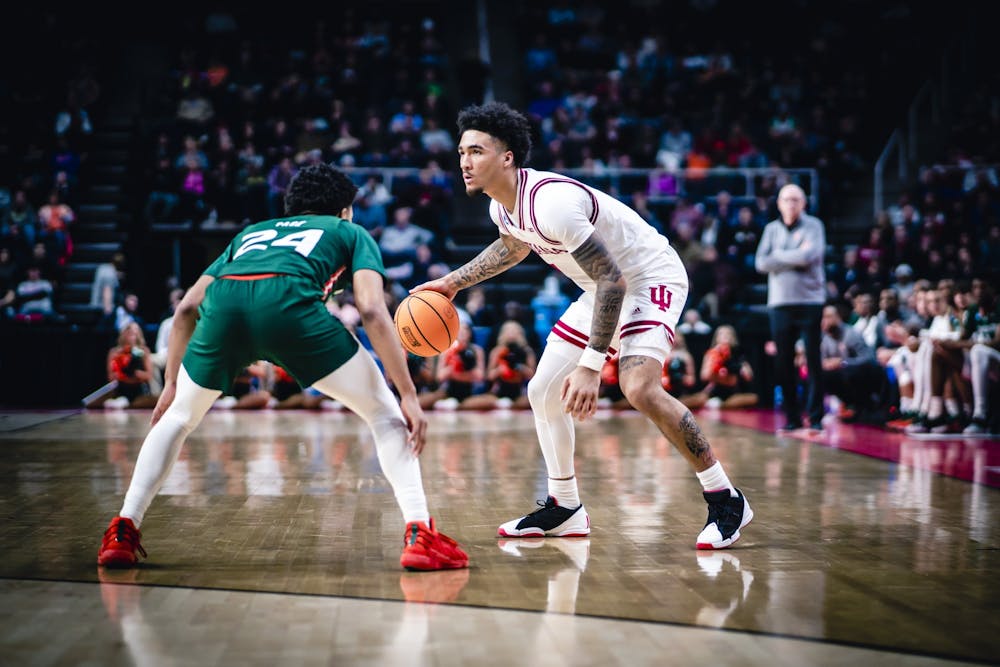ALBANY, NY — Indiana and Miami men’s basketball fit together like pieces of a puzzle.
Where one finds its identity in scrappiness and athleticism, the other prides itself in discipline and patience. What one lacks in post play, the other makes up for in an All-American power forward. And how one showcases scoring dominance in elite floor generals, the other is often left yearning for more.
The No. 4 seed Hoosiers and No. 5 seed Hurricanes were two squads with a nearly identical amount of talent, experience and heart heading into a do-or-die situation. But there’s no question which style of basketball was built to overpower and outlast the other.
Miami defeated Indiana 85-69 in the second round of the NCAA Tournament, sending head coach Mike Woodson’s squad back to Bloomington with an early start to the offseason.
While the Hoosiers didn’t stray glaringly far from their identity, the Hurricanes simply exposed the flaws therein.
“Even though we didn’t play nowhere near where I thought we should be playing, you’ve got to give Miami a lot of credit,” Woodson said postgame. “They played extremely well tonight.”
Indiana has preached a foundation of defense since Woodson’s arrival. Spearheaded by the program’s all-time leader in rebounds and blocks — senior forward Trayce Jackson-Davis — most of the Hoosiers’ successes this season came by way of aggressive, stifling play at that end of the floor.
Miami simply proved that great offense can crush good defense.
The Hurricanes outworked, outran, outsmarted and outplayed the Hoosiers for 40 minutes. Dominant backcourt play led the way as it has for Miami, which averages over 79 points per game, all season long.
[Related: Guard-heavy No. 5 Miami provides defensive challenge for No. 4 Indiana men’s basketball]
Hurricane guards junior Isaiah Wong, fifth-year senior Jordan Miller and sophomore Nijel Pack combined for 58 of 85 total points, making 51% of their 45 shot attempts. They tore apart their Hoosier defenders with their shifty handles, quick drives and spot-up shooting.
Jackson-Davis scored 23 points on merely 10 shots, the third-most attempts on his team. He worked his way through the lane over multiple Miami defenders, drawing a handful of fouls in the process.
The Hoosiers had a giant. But the Hurricanes had a three-headed monster.
“We’ve got a lot of versatile guards on the floor. It makes it really hard for them to guard us, especially when guys are making shots from the outside,” Pack said. “It kind of makes them expand their defense a little bit; they’ve got a principle of trying to pack the paint. Once they spread out, our foot speed is really fast, and it’s hard to keep us in front.”
Even with a burst of momentum from an 8-0 run to start the second half, Indiana’s lead was short-lived.
With every shot the Hoosiers made, the Hurricanes delivered one right back. With every full-court pressure trap Indiana threw, Miami weaved its way around for a wide-open dunk on the other end.
[Related: COLUMN: Indiana men’s basketball, a good team, couldn’t quite hang]
The Hurricanes never stopped playing Miami basketball. And the Hoosiers’ identity cracked in one detrimental aspect: rebounding.
In no game during Indiana’s season were the disparities between two conferences — the Big Ten and the Atlantic Coast — so obvious and influential. The former is a center’s league, focusing on pounding the ball inside to strong, explosive post players. The latter is a guard’s league, capitalizing off crafty ballhandlers and three-level scorers.
"We’re not the biggest team. We’re not the tallest team. We’re not the heaviest team. If we’re going to be successful, we’ve got to be the fastest team on the court,” Miami head coach Jim Larrañaga said.
So, when Indiana failed to execute in one of the pillars of its makeup — play like the bigger team it literally was — the game slipped out of its grasp when Miami took advantage of its likeness: athleticism.
The Hoosiers surrendered 20 offensive rebounds and 29 second-chance points. Hurricane sophomore forward Norchad Omier, standing below Jackson-Davis and graduate forward Race Thompson at 6-feet, 7-inches, valiantly swooped in from nearly anywhere around the basket to grab 17 rebounds, including nine on the offensive end. Jackson-Davis and Thompson combined for 15 boards total.
“They’re a great offensive rebounding team,” Jackson-Davis said. “They’ve got athletes. They would shoot shots, and everyone was crashing. They didn’t have guards getting back; everyone was going to get the ball.”
With a player of Jackson-Davis' caliber, aggressive guard defenders and veteran leaders, it would take most teams’ best shot and an extreme letdown by the Hoosiers for them to walk away with a loss. But neither of those things happened Sunday night.
Simply put, Miami’s basketball DNA — as rare as it might be — was perfectly constructed to expose the flaws in and beat a team like Indiana. The Hoosiers faced a tough matchup from the get-go. Desire, fight, grit and motivation weren’t the problem.
Sometimes it’s not about the intangibles; Sunday night was about the glaring mismatches, X’s and O’s and stylistic differences between not only two teams, but two major college basketball conferences and their drastically-different postseason journeys in years past.
But the end of Jackson-Davis’ career — a historic Hoosier era built on the Big Ten’s most sacred institutions — ushers in new beginnings and new possibilities for necessary growth and development. And soon, for Woodson and those who choose to stick with him, it won’t be long before it’s time to start piecing back together the puzzle of Indiana men’s basketball.
Follow reporters Evan Gerike (@EvanGerike) and Emma Pawlitz (@emmapawlitz), columnist Bradley Hohulin (@BradleyHohulin) and photographer Alex Paul (@alexpaulphoto) for updates throughout the Indiana men’s basketball season.




